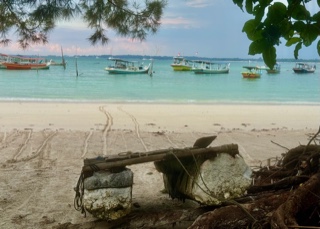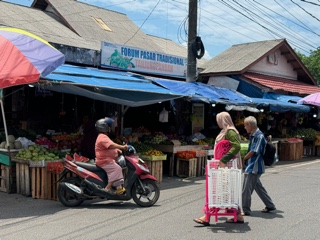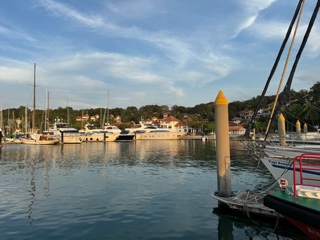Selamat Tinggal Indonesia

Casamara
John & Susan Simpson
Thu 31 Oct 2024 14:59
| Bali … Bawean … Borneo … Belitung … Benan … Batam. All the islands we visited in the final few weeks of our time in Indonesia had names beginning with the letter B. That must surely come in useful for a pub quiz at some point. “Name six islands in Indonesia beginning with the letter B!” We quickened the pace somewhat after we left Bali as our visas were due to expire on 28th October and, as we were due to lift Casamara out of the water for ‘winter’ storage in Malaysia a couple of weeks after that, we didn’t want to go to the expense of extending our visas for the sake of a few days. We would clear out of Indonesia in Batam and needed to be there at least 48 hours beforehand to allow time for any unexpected administrative hurdles. We covered the 1,000+ miles from Bali to Batam over two and a half weeks either in very long day sails or in chunks of around 250 miles that required one or two nights at a time at sea. It seemed strange to be night sailing again after months of sticking to day sails so that we could see the unlit hazards in the water. In the Java Sea (the bit from Bali to Batam) there were thankfully few unlit obstacles because there is much more shipping traffic, but as soon as the sun went down the night sky lit up with hundreds upon hundreds of bright lights from fishing boats. Picking our way between them was nerve-wracking as they don’t display the navigation lights that help us to determine in which direction they’re moving. Instead they seemed to dart here, there and everywhere when least expected, presumably chasing shoals of fish, and who knows whether they’re trailing nets, lines or whatever behind them. There was also some substantial merchant shipping, from big tankers travelling at 20 knots to the tug and barge combination which travels at around 3 knots but has the added hazard of a long cable strung between the two vessels.  Tug towing a massive barge - a common sight in the Java Sea We spent a couple of nights at anchor in Belitung where smooth rounded granite boulders were a feature of the landscape. Belitung (formerly known as Billiton) is a source of natural minerals and gave its name to a Dutch mining firm, formed in 1860, which later became part of BHP Billiton, one of the world’s largest mining companies. Tanjung Kelayang, where we anchored, was set up for local tourism and a host of small of local restaurants crowded in wooden huts along a beach of fine white sand. Scores of brightly painted ferry boats were lined up at the waters edge ready to take groups of tourists out to smaller islands in the bay. The water was turquoise and clear, and it was all very pretty but completely devoid of people. We presumed that we were deep into low season for Indonesian tourists.  Empty local restaurant seating at Tanjung Kelayang  Colourful ferry boats waiting for passengers, with makeshift polystyrene raft in the foreground  John wing foiling in front of granite rocks and ferry boat We hired scooters for the day with Derek and Letitia and went to explore the ‘city’ of Tanjung Pandan. After a trip to the supermarket and the traditional market to stock up on some essentials, we drove to the beach where we thought we might find a restaurant for lunch. Everywhere was distinctly ‘tutup' (closed) but we did come across the Marriott hotel which was ‘buka’ (open) and decided to treat ourselves. The four of us we were the only diners in the restaurant and completely outnumbered by the 6 waiting staff and 8 working in the kitchen. We were a bit surprised when, at the end of a pleasant meal, they were unable to provide us with coffee as the hotel had run out of milk. A Marriott hotel without any milk? Belitung gave the impression of being generally closed for tourist business!  Scenes from Tanjung Pandan Traditional Market After Belitung we spent a brief overnight stop at an idyllic anchorage on the sleepy little island of Benan. It was silent except for the swish of palm leaves, the put-put sound of local fishing boats and, of course, the call to prayer from the Mosque. We set off for the island of Batam early the next morning and as we approached it was as if we had crossed an invisible line into an industrialised modern world. Giant ships lay in rows at anchor in the seaway, planes landed at the airport every few minutes, fast ferries zipped past and everywhere we looked we could see industrial plants and dockland. It was a bit of an assault to the senses. Batam forms part of an industrial transport hub together with Malaysia and Singapore; in fact we could see clearly on the horizon the skyline of Singapore only 20 miles away. Although Batam is largely industrial, it has an area of modern resorts built around watersports facilities, including Nongsa Point Marina where we would spend a few nights as we completed the clearing out process.  Nongsa Point Marina Nongsa Point was the first marina with facilities we had visited since we left Cairns back in June and we revelled in the ability to go ashore without using the dinghy, to be able to plug into mains electric and to fill Casamara’s water tanks from a tap. Simple pleasures! The clearing out process was easy too; we just handed our documents to the Marina office staff, paid the fee and 24 hours later we were officially free to leave. After 120 days in Indonesia it was time to say farewell. Selamat tinggal. |